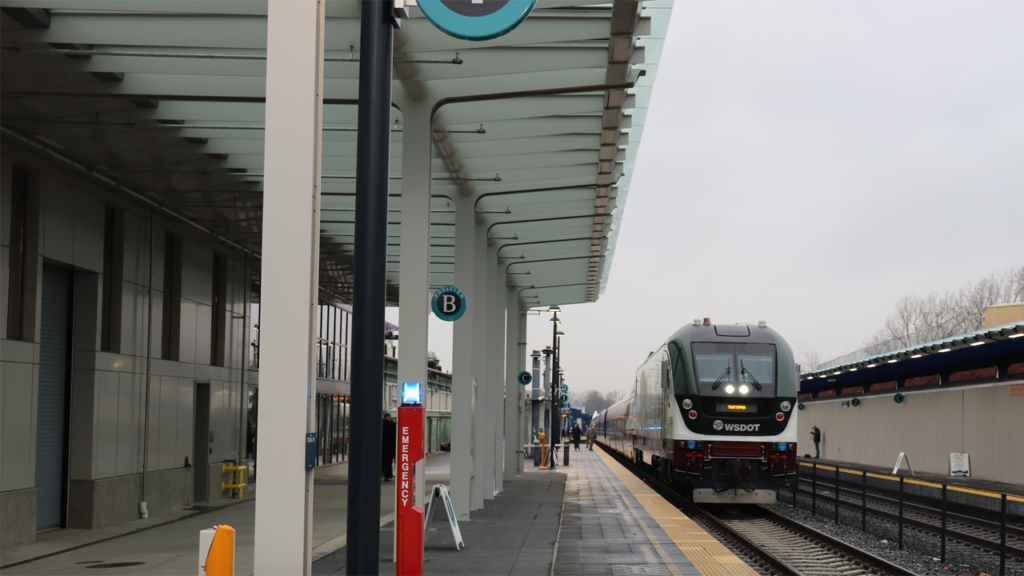
Settled: Amtrak Cascades Derailment Case
Written by Marybeth Luczak, Executive Editor
An aerial view of the Dec. 18, 2017 derailment. (Photo courtesy of Washington State Patrol.)
A settlement has been reached more than four years after Amtrak Cascades train 501, on its inaugural Point Defiance Bypass run, derailed in DuPont, Wash., as it entered a 30-mph curve at approximately 79 mph.
The Seattle Times on June 6 reported that “Amtrak has agreed to pay former engineer Steven Brown for his pain and suffering caused by the [Dec. 18,] 2017 derailment when his train sped off a curve in DuPont, killing three people and injuring dozens.
“‘It was a large settlement. Steve and his family will be taken care of for his life,’ said Fred Bremseth, a Minneapolis attorney whose firm handled the case. The settlement amount is undisclosed, after the agreement was filed Friday [June 3] in Pierce County Superior Court.
“‘We think that it substantiates that it is Amtrak’s fault and not Mr. Brown’s,’ Bremseth said.”
The derailment of Southbound Amtrak Cascades 501, bound for Portland, Ore., from Seattle, Wash., caused the lead locomotive and four passenger cars to fall from an overpass onto Interstate 5 where they struck eight vehicles. Three of the 77 train passengers were killed, and 57 passengers and crew members aboard the train and eight people on the highway were injured. The National Transportation Safety Board (NTSB) announced in May 2019 that failure to provide an effective mitigation method for a hazardous curve and inadequate training of a locomotive engineer led to the derailment.
The NTSB said during a public meeting held May 21, 2019 that right-of-way owner Central Puget Sound Regional Transit Authority (Sound Transit) “failed to adequately address the hazard associated with a curve that required the train to slow from 79 mph to 30 mph in order to safely traverse it,” Railway Age reported at that time. “Positive Train Control was not in use for the track at the curve.
“In addition, the engineer was somewhat familiar with the route from observational rides and three training runs, but the accident was the first time he operated the train on that route in revenue service. So the NTSB determined the engineer had insufficient training on both the route and the equipment.
“Furthermore, Amtrak had equipped—though it wasn’t required to by the Federal Railroad Administration (FRA)—the locomotive with an inward-facing image recorder that provided investigators with both a visual and audio recording of crewmember activities during the accident.
“The recording allowed investigators to reconstruct a second-by-second account of the conductor and engineer’s actions and words throughout the entire trip. According to the NTSB, the pair engaged in brief conversations throughout the trip; as the train passed the only sign warning of a speed reduction prior to the accident curve, the engineer was not engaged in conversation and was looking ahead.
“The engineer told investigators that he did not see the speed reduction sign. Recordings show that he took no action to reduce speed prior to the derailment. Investigators concluded the brief conversations between the engineer and the conductor did not distract them from their duties or their abilities to identify the speed reduction sign.
“Responsibility for the planning, safety and oversight of the Cascades involved numerous organizations, such as Amtrak, the Washington State Department of Transportation, the FRA and the Central Puget Sound Regional Transit Authority. Investigators found there was a general sense that none of the participants fully understood the scope of their roles and responsibilities as they pertained to the safe operation of the service, which allowed critical safety areas to be unaddressed.
“On the heels of the investigation, the NTSB issued a total of 26 safety recommendations to the FRA, the Washington State Department of Transportation, Oregon Department of Transportation, Central Puget Sound Regional Transit Authority and the United States Department of Defense. In addition, the NTSB reiterated three recommendations to the FRA.”
According to June 6, 2022, Seattle Times report, “Federal railroad law requires Amtrak to prove an employee was the sole cause of the crash or else pay compensation. Last year, Pierce County Superior Court Judge Karena Kirkendoll granted Brown’s request to sue for damages. Brown, who is now 60, broke several bones in his face and torso when most of the train flew off the trestle onto Interstate 5 beneath.”
An Amtrak spokesman on June 7 told Railway Age that the railroad did not have a statement.

It reported on Nov. 9, 2021, that service is returning following “intensive system testing, crew qualifications and safety certification” in partnership with Sound Transit (Central Puget Sound Regional Transit Authority) and the Washington State Department of Transportation.
Since the derailment, Amtrak said that all involved agencies have worked to:
• Activate positive train control (PTC). All passenger rail corridors in Washington, including the Point Defiance Bypass, have train control technology.
• Develop and implement an Amtrak Safety Management System (SMS), which “includes policies and processes to proactively identify and mitigate risks, enhanced reporting standards, expanded crew training, and redesigned safety training courses to create an improved safety culture and drive safety performance.”
• Implement step-down speed restrictions. “Working with Sound Transit, progressive speed reductions were implemented to ensure trains operate at required speeds across the route,” Amtrak reported.
• Upgrade simulator programs. “High-fidelity simulators with route specific details and conditions were utilized to greatly increase training opportunities on the route,” according to Amtrak.
• Conduct extensive public outreach on railroad safety. “Our partners and Amtrak conducted outreach in communities surrounding the Point Defiance Bypass, including DuPont, Lakewood, Tacoma, and Joint Base Lewis-McChord, prior to the return of service,” the railroad said.
Additionally, Amtrak, Sound Transit and Washington State Department of Transportation “have implemented or are continuing to pursue all safety recommendations set forth by the NTSB,” Amtrak said.



